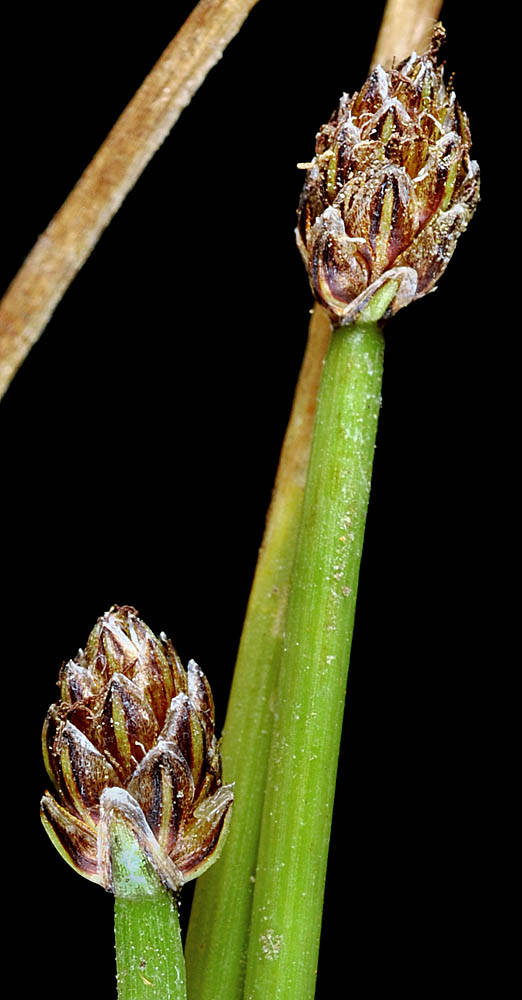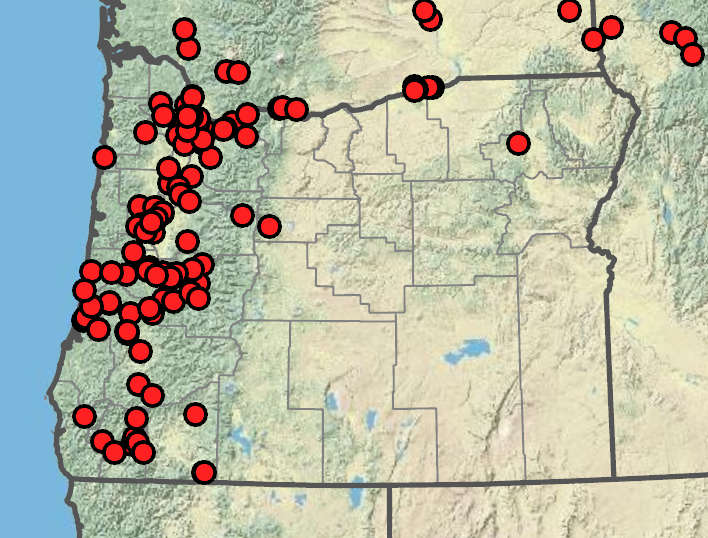Eleocharis engelmannii
Eleocharis obtusa
Engelmann's spikerush
blunt spikerush
terete, 2–40 cm × 0.5–1.5(2) mm.
terete, 3–50(90) cm × 0.2–2 mm.
lanceoloid to subcylindric, 5–10(20) × 2–3(4) mm;
proximal scale empty, encircling approximately 67% of culm; floral scales 25–100(200), 8–12 per mm of rachilla, 2(2.5) × 1–1.3 mm;
apex narrowly rounded to subacute.
usually broadly ovoid; (2)5–13 × (2)3–4 mm; floral scales 15–150+, 8–20 per mm of rachilla, 1.5–2.5 × 1–1.5 mm;
apex broadly rounded.
perianth bristles present or often absent; (0)5–8; about as long as the achenes;
anthers 0.3–0.7(1) mm;
stigmas 2–3.
perianth bristles (5)6–7, rarely 0, slightly to usually greatly exceeding tubercle;
stamens (2)3;
anthers 0.3–0.6 mm;
stigmas usually 3 and 2 in the same spike.
biconvex or to 33% greatly compressed trigonous, 0.9–1.1(1.5) × 0.7– 1.1 mm.
biconvex or to 33% greatly compressed trigonous, 0.9–1.2(1.3) × 0.7–0.9 mm.
persistent, apex of distal leaf sheath obtuse to acute, with tooth to 0.3 mm.
persistent, apex of distal leaf sheath obtuse to acute; tooth to 0.3 mm.
depressed, subdeltoid, 0.1–0.3(0.4) × 0.6–0.9(1) mm, 10–40% as high as wide, 25% or less as high as achene, 90% as wide as achene.
deltoid 0.35–0.5 × (0.4)0.5–0.8 mm, 33–50% as high as wide, 33–50% as high and 67–90% as wide as achene.
=10.
Eleocharis engelmannii
Eleocharis obtusa
Freshwater shores exposed by seasonal low water levels, marshes, disturbed wetlands. 50–500 m. WV. CA, ID, WA; north to British Columbia, east to MA, southeast to AL. Native.
Eleocharis engelmannii is similar to E. ovata and the much more common E. obtusa but has markedly shorter tubercles and usually more cylindric spikes.
Freshwater shores exposed by seasonal low water levels, marshes, and disturbed wetlands. 0–1300 m. BW, Casc, Col, CR, ECas, Est, Sisk, WV. CA, ID, WA; north to British Columbia, east to Nova Scotia, southeast to FL, HI. Native.
Eleocharis obtusa is our most common tough, annual, cespitose spikerush. It is sometimes considered to be the same species as E. ovata, which generally has two stamens and two stigmas and has narrower tubercles. See also E. engelmannii.
Barbara Wilson, Richard Brainerd, Nick Otting
Barbara Wilson, Richard Brainerd, Nick Otting
- Local floras:
BC,
CA,
OR,
WA
- Local Web sites:
CalFlora,
CalPhotos,
Flora NW,
PNW Herbaria
WildflowerSearch
iNaturalist (observations)
USDA Plants Database
- LBJ Wildflower Center
- SEINet
- Plants of the World Online
- Encyclopedia of Life
- Wikipedia
- Google Image Search
- Local floras:
BC,
CA,
OR,
WA
- Local Web sites:
CalFlora,
CalPhotos,
Flora NW,
PNW Herbaria
WildflowerSearch
iNaturalist (observations)
USDA Plants Database
- LBJ Wildflower Center
- SEINet
- Plants of the World Online
- Encyclopedia of Life
- Wikipedia
- Google Image Search




